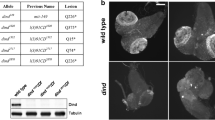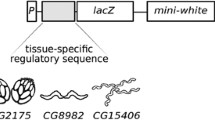Summary
The developmental patterns of embryos produced by female germ line cells homozygous for null-enzyme mutations of dunce and for dunce in combination with each of three different rutabaga mutations are compared with the normal pattern. At least three discrete developmental defects at progressive stages following fertilization can be identified and correlated with the loss of adenylate cyclase activity caused by rutabaga mutations, suggesting that the defects are caused by elevated cyclic AMP levels in female germ line cells. The earliest defect occurs soon after fertilization and affects DNA replication and mitosis, prevents nuclear migration, and leads to large polyploid nuclei. A later defect prevents cleavage nuclei from migrating into, or dividing in, the posterior region of the egg. The last affects the developmental behavior or fate of blastoderm cells. Some of these defects mimic those produced by previously described maternal-effect mutations.
Similar content being viewed by others
References
Bellen HJ, Gregory BK, Olsson CL, Kiger JA, Jr (1987) Two Drosophila learning mutants, dunce and rutabaga, provide evidence of a maternal role for cAMP on embryogenesis. Dev Biol 121:432–444
Boswell RE, Mahowald AP (1985) tudor, a gene required for assembly of the germ plasm in Drosophila melanogaster. Cell 43:97–104
Chen C-N, Denome S, Davis RL (1986) Molecular analysis of cDNA clones and the corresponding genomic coding sequences of Drosophila dunce + gene, the structural gene for cAMP phosphodiesterase. Proc Natl Acad Sci USA 83:9313–9317
Dambly-Chaudiere C, Ghysen A (1986) The sense organs in the Drosophila larva and their relation to the embryonic pattern of sensory neurons. Wilhelm Roux's Arch 195:222–228
DeCamilli P, Moretti M, Denis-Donini S, Walter UL, Lohmann SM (1986) Heterogeneous distribution of the cAMP receptor protein RII in the nervous system: evidence for its intracellular accumulation on microtubules, microtubule-organizing centers, and in the area of the golgi complex. J Cell Biol 103:189–203
Degelmann A, Hardy PA, Perrimon N, Mahowald AP (1986) Developmental analysis of the torso-like phenotype in Drosophila produced by a maternal-effect locus. Dev Biol 115:479–489
Elgin SCR, Miller DW (1978) Mass rearing of flies and mass production and harvesting of embryos. In: Ashburner M, Wright TRF (eds) The genetics and biology of Drosophila, vol 2a. Academic Press, Inc, London New York San Francisco, pp 112–120
Freeman M, Nüsslein-Volhard C, Glover DM (1986) The dissociation of nuclear and centrosomal division in gnu, a mutation causing giant nuclei in Drosophila. Cell 46:457–468
Foe VE, Alberts BM (1983) Studies of nuclear and cytoplasmic behavior during the five mitotic cycles that precede gastrulation in Drosophila embryogenesis. J Cell Sci 61:31–70
Jan LY, Jan YJ (1982) Antibodies to horseradish peroxidase as specific neuronal markers in Drosophila and in the grasshopper embryos. Proc Natl Acad Sci USA 79:2700–2704
Jürgens G (1987) Segmental organization of the tail region in the embryo of Drosophila melanogaster. A blastoderm fate map of the cuticle structures of the larval tail region. Roux's Arch Dev Biol 196:141–157
Karr TL, Alberts BM (1986) Organization of the cytoskeleton in early Drosophila embryos. J Cell Biol 102:1494–1509
Kiger JA Jr, Salz HK (1985) Cyclic nucleotide metabolism and physiology of the fruit fly Drosophila melanogaster. Adv Insect Physiol 18:141–179
King RC (1970) Ovarian development in Drosophila melanogaster. Academic Press, New York and London
Lehmann R, Nüsslein-Volhard C (1986) Abdominal segmentation, pole cell formation, and embryonic polarity require the localized activity of oskar, a maternal gene in Drosophila. Cell 47:141–152
Lindsley DL, Grell EH (1968) Genetic variations of Drosophila melanogaster. Carnegie Inst Wash Publ No. 627
Lindsley D, Zimm G (1985) The genome of Drosophila melanogaster. 1. Genes A-K. Dros Inf Ser 62
Livingstone MS (1985) Genetic dissection of Drosophila adenylate cyclase. Proc Natl Acad Sci USA 82:5992–5996
Livingstone MS, Sziber PP, Quinn WG (1984) Loss of calcium/ calmodulin responsiveness in adenylate cyclase of rutabaga, a Drosophila learning mutant. Cell 37:205–215
Lohs-Schardin M, Sander K, Cremer C, Cremer T, Zorn C (1979) Localized ultraviolet laser microbeam irradiation of early Drosophila embryos: fate maps based on location and frequency of adult defects. Dev Biol 68:533–545
Mahowald AP, Caulton JH, Edwards MK, Floyd AD (1979) Loss of centrioles and polyploidization in follicle cells of Drosophila melanogaster. Exp Cell Res 118:404–410
Mahowald AP, Strassheim JM (1970) Intracellular migration of centrioles in the germarium of Drosophila melanogaster: an electron microscopic study. J Cell Biol 45:306–320
Mitchison TJ, Sedat J (1983) Localization of antigenic determinants in whole Drosophila embryos. Dev Biol 99:261–264
Mohler JD, Carroll A (1984) Sex-linked female-sterile mutations in the Iowa collection. Dros Inf Serv 60:236–241
Nigg EA, Schäfer G, Hilz H, Eppenberger HM (1985) CyclicAMP-dependent protein kinase type II is associated with the golgi complex and with centrosomes. Cell 41:1039–1051
Nüsslein-Volhard C (1977) A rapid method for screening eggs from single Drosophila females. Dros Inf Serv 52:166
Piperno G, Fuller M (1985) Monoclonal antibodies specific for an acetylated form of alpha-tubulin recognize the antigen in cilia and flagella from a variety of organisms. J Cell Biol 101:2085–2094
Salz HK, Davis RL, Kiger JA, Jr (1982) Genetic analysis of chromomere 3D4 in Drosophila melanogaster: the dunce and spermamotile genes. Genetics 100:587–596
Salz HK, Kiger JA, Jr (1984) Genetic analysis of chromomere 3D4 in Drosophila melanogaster: II, regulatory sites for the dunce gene. Genetics 108:377–392
Schüpbach T, Wieschaus E (1986) Maternal-effect mutations altering the anterior-posterior pattern of the Drosophila embryo. Wilhelm Roux's Arch 195:302–317
Underwood EM, Turner FR, Mahowald AP (1980) Analysis of cell movements and fate mapping during early embryogenesis in Drosophila melanogaster. Dev Biol 74:2860–301
Van Der Meer JM (1977) Optically clean and permanent whole mount preparation for phase contrast microscopy of cuticular structures of insect larvae. Dros Inf Serv 52:160
Author information
Authors and Affiliations
Rights and permissions
About this article
Cite this article
Bellen, H.J., Kiger, J.A. Maternal effects of general and regional specificity on embryos of Drosophila melanogaster caused by dunce and rutabaga mutant combinations. Roux's Arch Dev Biol 197, 258–268 (1988). https://doi.org/10.1007/BF00380019
Received:
Accepted:
Issue Date:
DOI: https://doi.org/10.1007/BF00380019




